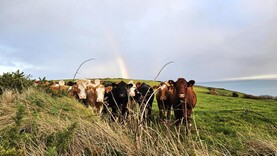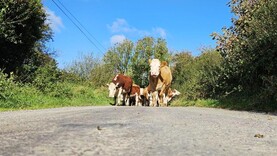We got the ‘all clear’ in the TB test a fortnight ago, and rain and fog hung around for a week afterwards, so the stock that were housed before the test remained indoors since.
Some weaned cows will get out again, but at this stage, with conditions so wet, this year’s grazing is at an end for most stock.
Most of the cows and all the heifers were scanned after the test, and only those who were keeping the stock bulls company remain to be scanned – so, I don’t have a full in-calf rate yet.
The heifers were the priority, as any not in calf will move over to finishing. I tried something different with them this year.
Numbers were lower than usual and aside from one that was stone-mad, and another that was a twin to a bull, I was happy enough for any of the rest to remain on as cows.
The plan was to leave the bull with them for 30 or 35 days until they were either in calf or not after that time. Overall, 89% were in calf.
Other work meant that removing the bull was delayed by a week, and the three heifers that snuck into week six can count themselves lucky. Only a pair of heifers will calve outside of this timeframe.
An opportunity arose to pick up a few pedigree heifers earlier in the year, so I took it and they got AI, but two repeated and were picked up by the bull.
The focus on fertility paid off with the main herd too. A lot of the cows were bulled in the first three weeks the bull was with them too, so it means March will be fairly busy around the yard.
It’s a ‘survival of the fittest’ breeding policy, but it simplifies things too. They must thrive in a ‘no frills’ environment with a forage only diet for the herd, so costs are kept tight.
There are cows in the herd heading for their ninth, tenth and twelfth lactation under the same parameters, and they have managed well. A bonus is that they’re having heifer calves. Hopefully, these will have similar low maintenance and staying power.
It’s a simple cost-effective system, with no throwing money attempting to keep the “best” heifer in the herd at all costs.
Of the empties, any fleshed older cows will be sold before the year is out, and any first calvers not in calf will be stored over the winter and let to grass early with a target finish of early summer.
That system I tried with the heifers could be around for the long haul. There were more heifer calves born this year, so if I am to implement it in 2024, it would mean running all the heifers with the bull, but for a time frame of 21 to 30 days instead, or less, depending on how the rest of scanning works out.
A pooled dung sample was taken from the heifers and, similar enough to one taken early in summer, they were negative for fluke and worms. It surprised me, given how wet the summer was.
There was a low presence of rumen fluke, so what I’ll do is dose any that appear to be thinner or whose coat doesn’t have the same shine as the others, rather than blanket treat them.






 This is a subscriber-only article
This is a subscriber-only article










SHARING OPTIONS: